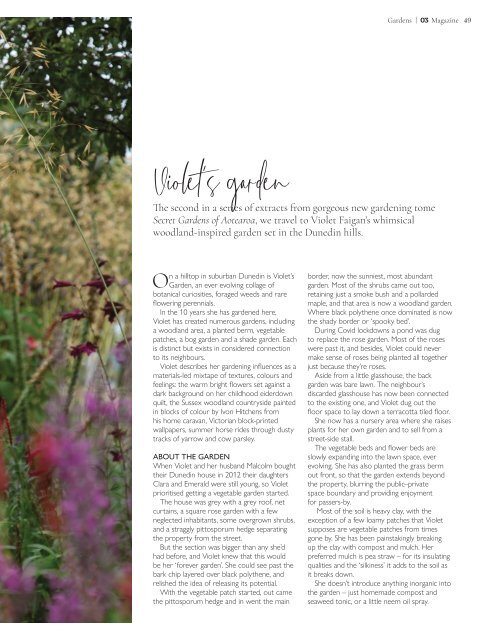Create successful ePaper yourself
Turn your PDF publications into a flip-book with our unique Google optimized e-Paper software.
Gardens | <strong>Magazine</strong> 49<br />
Violet’s garden<br />
The second in a series of extracts from gorgeous new gardening tome<br />
Secret Gardens of Aotearoa, we travel to Violet Faigan’s whimsical<br />
woodland-inspired garden set in the Dunedin hills.<br />
On a hilltop in suburban Dunedin is Violet’s<br />
Garden, an ever evolving collage of<br />
botanical curiosities, foraged weeds and rare<br />
flowering perennials.<br />
In the 10 years she has gardened here,<br />
Violet has created numerous gardens, including<br />
a woodland area, a planted berm, vegetable<br />
patches, a bog garden and a shade garden. Each<br />
is distinct but exists in considered connection<br />
to its neighbours.<br />
Violet describes her gardening influences as a<br />
materials-led mixtape of textures, colours and<br />
feelings: the warm bright flowers set against a<br />
dark background on her childhood eiderdown<br />
quilt, the Sussex woodland countryside painted<br />
in blocks of colour by Ivon Hitchens from<br />
his home caravan, Victorian block-printed<br />
wallpapers, summer horse rides through dusty<br />
tracks of yarrow and cow parsley.<br />
ABOUT THE GARDEN<br />
When Violet and her husband Malcolm bought<br />
their Dunedin house in 2012 their daughters<br />
Clara and Emerald were still young, so Violet<br />
prioritised getting a vegetable garden started.<br />
The house was grey with a grey roof, net<br />
curtains, a square rose garden with a few<br />
neglected inhabitants, some overgrown shrubs,<br />
and a straggly pittosporum hedge separating<br />
the property from the street.<br />
But the section was bigger than any she’d<br />
had before, and Violet knew that this would<br />
be her ‘forever garden’. She could see past the<br />
bark chip layered over black polythene, and<br />
relished the idea of releasing its potential.<br />
With the vegetable patch started, out came<br />
the pittosporum hedge and in went the main<br />
border, now the sunniest, most abundant<br />
garden. Most of the shrubs came out too,<br />
retaining just a smoke bush and a pollarded<br />
maple, and that area is now a woodland garden.<br />
Where black polythene once dominated is now<br />
the shady border or ‘spooky bed’.<br />
During Covid lockdowns a pond was dug<br />
to replace the rose garden. Most of the roses<br />
were past it, and besides, Violet could never<br />
make sense of roses being planted all together<br />
just because they’re roses.<br />
Aside from a little glasshouse, the back<br />
garden was bare lawn. The neighbour’s<br />
discarded glasshouse has now been connected<br />
to the existing one, and Violet dug out the<br />
floor space to lay down a terracotta tiled floor.<br />
She now has a nursery area where she raises<br />
plants for her own garden and to sell from a<br />
street-side stall.<br />
The vegetable beds and flower beds are<br />
slowly expanding into the lawn space, ever<br />
evolving. She has also planted the grass berm<br />
out front, so that the garden extends beyond<br />
the property, blurring the public–private<br />
space boundary and providing enjoyment<br />
for passers‐by.<br />
Most of the soil is heavy clay, with the<br />
exception of a few loamy patches that Violet<br />
supposes are vegetable patches from times<br />
gone by. She has been painstakingly breaking<br />
up the clay with compost and mulch. Her<br />
preferred mulch is pea straw – for its insulating<br />
qualities and the ‘silkiness’ it adds to the soil as<br />
it breaks down.<br />
She doesn’t introduce anything inorganic into<br />
the garden – just homemade compost and<br />
seaweed tonic, or a little neem oil spray.


















